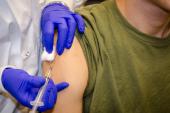Email Nudges Spur Patients With a History of Acute MI to Get Flu Shots
(UPDATED) Pooled data from three NUDGE-FLU trials show targeted messaging about CV benefits is helpful in these high-risk patients.

CHICAGO, IL—For patients with a history of acute MI who are vulnerable to the cardiovascular risks posed by influenza infection, email reminders can encourage them to get their annual jab, according to a pooled analysis of the NUDGE-FLU trial program.
Targeted messaging that mentioned the protective effects of vaccination for CV health was especially effective among the vaccine hesitant who hadn’t gotten their flu shot the year before and among younger patients with more-recent MIs.
Investigator Ankeet S. Bhatt, MD (Kaiser Permanente San Francisco Medical Center, CA), at a press conference prior to his late-breaking presentation at the American Heart Association 2024 Scientific Sessions, noted that beyond influenza having a broad impact on morbidity and mortality, it “also increases the risk of cardiovascular events, including acute myocardial infarction.”
In 2021, results from the IAMI trial made the case that, for patients who’ve already had an MI, getting a flu shot can reduce this added risk of cardiovascular events through 1-year follow-up, Bhatt pointed out. This led to strong recommendations for influenza vaccination as secondary prevention in cardiovascular guidelines, he said. “Despite these recommendations, data suggest vaccination rates in this high-risk cohort are suboptimal, therefore highlighting the need for strategies to durably improve vaccination in [this population].”
The NUDGE-FLU family of trials, based in Denmark, leveraged the country’s government email system to deliver electronic nudges that reminded study participants to get their influenza vaccination.
Orly Vardeny, PharmD (Minneapolis VA Health Care System, MN), who discussed the pooled results at the media briefing, spoke to influenza’s heavy footprint in the United States. In the 2023-2024 flu season, data from the US Centers for Disease Control and Prevention show “influenza resulted in 34 million symptomatic illnesses, 15 million medical visits, upward of 380,000 hospitalizations, and 17,000 deaths,” Vardeny reported. Nearly 50% of those hospitalized have cardiovascular disease.
“Each year, individuals make a choice over where they will receive or not receive influenza vaccination,” she stressed. Some always choose to get the shot, others always choose not to, and some enter the season without having made up their minds. The latter group “is likely where implementation efforts can be most impactful at moving the needle,” said Vardeny.
Valuably, the NUDGE-FLU results point to “what message will resonate with an unsure, high-risk group with a history of myocardial infarction,” she added.
There’s the question, though, of how well that message would work in countries other than Denmark, where flu shots are free, healthcare is universal, and the government both can deliver nudges through its own electronic system and track influenza vaccination rates in a nationwide registry.
Bhatt said some aspects are still generalizable to the US. “While there are a few unique aspects to the Danish healthcare system, we have corollaries to that in the United States,” he told TCTMD. “We have large healthcare delivery systems that allow us to communicate with patients through online portals . . . and we also have the ability through electronic health records to be able to routinely and systemically capture influenza vaccination in select healthcare environments.”
That said, given the strong “feelings around vaccination” that are becoming a hot-button issue in this country, “I think it’s imperative that validation studies occur in the United States where there are large, pervasive implementation gaps in influenza vaccination,” Bhatt stressed.
Acute MI in NUDGE-FLU
For their pooled analysis, published in JAMA Cardiology, Bhatt and colleagues culled data from NUDGE-FLU (2022-2023 season; patients aged ≥ 65 years), NUDGE-FLU-2 (2023-2024 season also ≥ 65 years), and NUDGE-FLU-CHRONIC (2023-2024 season; patients aged 18-64 with a chronic condition). The intervention in NUDGE-FLU involved nine different behavioral science-informed letters delivered electronically by the Danish government, and in the other two studies, it consisted of six such letters.
More than 2.1 million people (mean age 71.1 years; 51.9% women) in Denmark were randomized to receive nudges or usual care. Among them, 59,458 (3.8%) had a history of acute MI.
At baseline, influenza vaccination rates were equally high between older patients who’d had an acute MI and those who had not in both NUDGE-FLU (84% vs 82%) and NUDGE-FLU-2 (78% vs 76%). In the younger NUDGE-FLU-CHRONIC population, there were “pervasive implementation gaps in receipt of influenza vaccination,” Bhatt noted, with rates of 40% and 36% for patients with and without an MI history.
Vaccine uptake with any nudge letter, the primary endpoint, similarly improved for patients no matter if they did or didn’t have a history of acute MI (+1.81 vs +1.32 percentage points; P for interaction = 0.09).
When patients received a letter specifically designed to highlight the benefits of CV vaccination, those who had a history of acute MI were more apt to get a flu shot than those without a history (+3.91 vs +2.03 percentage points; P for interaction = 0.002). Importantly, this nudge “was a very simple intervention,” where just one sentence describing the flu shot’s ability to reduce risks of MI and heart failure was added to the standard letter, Bhatt said.
Among acute MI patients, the CV-focused letter had a greater effect in those who weren’t vaccinated in the prior season than in those who’d gotten a shot the year before (+13.7 vs +1.48 percentage points; P for interaction < 0.001). The targeted messaging also was particularly effective among younger patients with chronic disease who’d had an acute MI more recently versus farther in the past (P for interaction < 0.001).
“If validated, a cardiovascular-focused messaging strategy should be employed as a simple, scalable, and effective tool to improve vaccination rates amongst high-risk patients with a history of acute myocardial infarction,” Bhatt concluded.
Session moderator Donald Lloyd-Jones, MD (Northwestern University Feinberg School of Medicine, Chicago, IL), asked Bhatt about the intervention itself and whether more-direct wording might work better. “Although I know it was behavior science-informed,” he said, “the nudge was a little soft, right? . . . What about a little bit more of an elbow or a shove?”
The study was designed a little differently than that, Bhatt explained. “We aimed to test different behavioral strategies [but] did not necessarily randomize to intensity of that nudge.” For example, one letter implied that patients missing out on vaccination could incur harm, while another had an expert sharing the message that getting a shot is helpful.
The CV-focused letter similarly featured the benefits of vaccination, he said. “But now that we've established that this ‘CV gain’ nudge, at least in the population study, may be effective in moving the needle, I think there is the power for subsequent questions to test the intensity on top of that,” he agreed.
Mohammad Madjid, MD (University of California, Los Angeles), and Payam Safavi-Naeini, MD (Texas Heart Institute, Houston, TX), in a JAMA Cardiology editorial, agree that targeted messaging around vaccination holds promise.
“However, caution must be exercised when generalizing the results of this Danish study to the US population to improve the influenza vaccination rate,” they write. In the United States, just one-third of adults aged 18 to 44 years and around half of those aged 45 to 64 get their flu shot, which the editorialists suggest is perhaps due to differences not just between health systems but also in health awareness.
“Beyond economic and access issues, the experience of suboptimal acceptance of the COVID-19 vaccine despite its free accessibility in the US underscores the complexity of the approach to vaccination and highlights the impact of social media misinformation and other sources of vaccine hesitancy,” Madjid and Safavi-Naeini say. They call for a coordinated effort to overcome these barriers that involves “private and governmental sectors, physicians, pharmacists, nurses, and other healthcare professionals.”
Caitlin E. Cox is News Editor of TCTMD and Associate Director, Editorial Content at the Cardiovascular Research Foundation. She produces the…
Read Full BioSources
Bhatt AS, Johansen ND, Vaduganathan N, et al. Electronic nudges and influenza vaccination among patients with a history of myocardial infarction: insights from 3 nationwide randomized clinical trials. JAMA Cardiol. 2024;Epub ahead of print.
Madjid M, Safavi-Naeini P. Power of digital nudges to boost influenza vaccination rates. JAMA Cardiol. 2024;Epub ahead of print.
Disclosures
- NUDGE-FLU was funded by Sanofi Pasteur. NUDGE-FLU-2 and NUDGE-FLU-CHRONIC had no external funding.
- Bhatt reports receiving personal fees from Sanofi, Merck, and Novo Nordisk outside the submitted work.
- Madjid reports receiving consultant fees from Sanofi Pasteur outside the submitted work.
- Safavi-Naeini reports no relevant conflicts of interest.





Comments